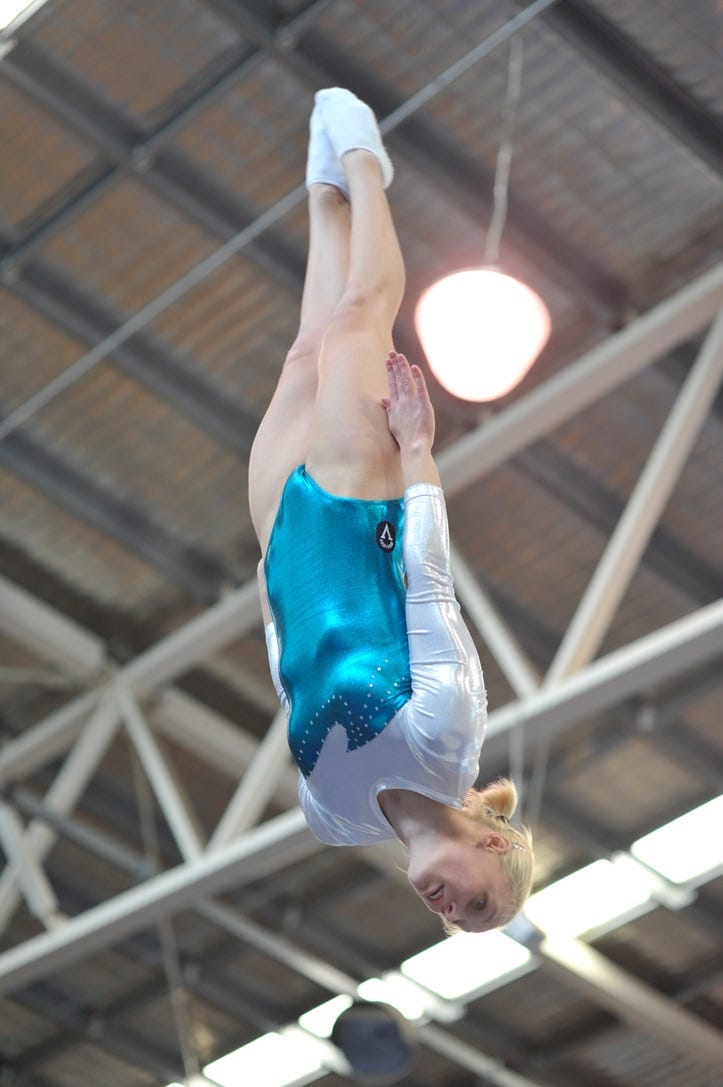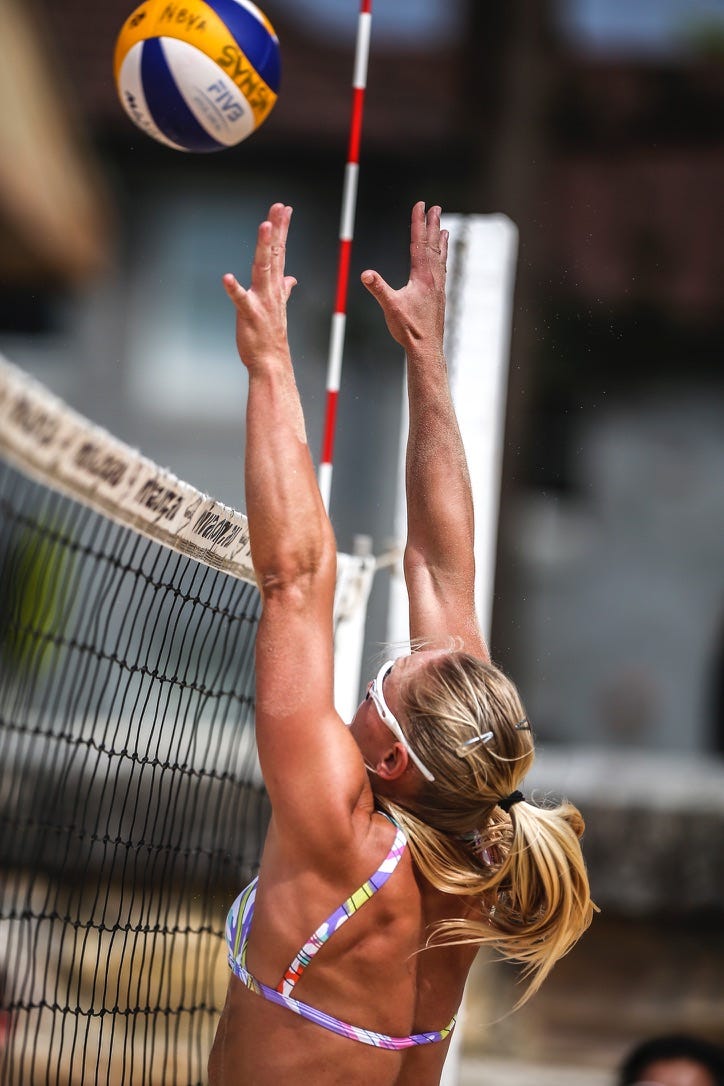MASTERY: What lies beyond unconscious competence
When learning skills we go from 'this will be easy', to 'oh crap, it's much harder than I thought' to 'I'm finally getting it'. Eventually we reach mastery. How can we go even further?
‘How do you do all those somersaults? What do you think about while you are upside down?’
Trampolining is a crazy sport. Imagine jumping 10 meters in the air. And doing double and triple somersaults. With twists. All while judges look on and critique even your little finger being out of place.
What do I think about while upside down? My answer is very boring:
‘Nothing’.
I’ve done my routines hundreds and hundreds of times. Because of that repetition I’ve reached a level of mastery that doesn’t require thought. Double somersaults feel automatic. It’s muscle memory. Intuitive and second nature.
If you think about the skills you are very good at, you can probably also do them without thinking.
It’s called unconscious competence.
The 4 stages of skill acquisition
In the 1970s Noel Burch developed the ‘four stages of learning’ model. It describes the skill acquisition journey we go on from completely ignorant all the way through to mastery. The four stages are:
Unconscious incompetence (ie. ignorance - 'how hard could it be')
Conscious incompetence (ie. awareness - 'oh crap, there's a ton to learn')
Conscious competence (ie. learning and teaching - 'I'm getting good at this, but I have to concentrate')
Unconscious competence (ie. mastery - 'I can do this without thinking')
Here’s a quick run down of each of them:
1. Unconscious incompetence
‘I’m going to be like Jackie Chan,’ I thought.
I’d just shown up to my first Brazilian Ju Jitsu class. And I was imagining myself doing high kicks, throwing bad guys against the wall, and smiling while I put down 7 opponents at once.
10 minutes later…
‘Wait, where does my elbow go again?’ I asked the coach. He patiently demonstrated the move again. And then corrected my foot placement too.
In the first phase of learning you are ignorant, and not even aware of your own ignorance. Think of:
The college graduate filled with confidence, right up until their first day at a real job
A 16 year old getting behind the wheel of a car for the first time thinking ‘I’ve got this, it’ll be easy’’
Or the 1 in 8 UK men who think they could win a point off Serena Williams (watch the hilarious results of this)
Unconscious competence is often characterised by over-confidence. You feel good about your ability to master something because you really don’t know how difficult, and how long, the journey will be.
Jackie Chan has nothing to worry about from me.
2. Conscious incompetence
I recently had my first tennis lesson. Before I was allowed to even touch a ball, the coach spent 5 minutes telling me how to hold the racket.
‘Grip the racket?!’ I thought in disbelief. I thought all I had to learn was how to serve, forehand, backhand, and volley. Abruptly I realised that if we were spending so much time on something as small as my hand placement on the racket, then there were probably a million other tiny skills I’d have to master.
Conscious incompetence is where you get a bucket of ice water dropped over your head. You suddenly learn about all the things that you need to learn. It’s the ‘oh crap’ moment when you realise just how skilful masters of the craft are, and just how far you have to go.
3. Conscious competence
My dad taught me to drive. There were moments I’m sure he questioned that decision. I remember it taking every iota of concentration - I had the radio off, a death grip on the steering wheel, and a very, very delicate touch on the accelerator.
Still, the first time we went on the road I freaked out… because a car was coming in the other direction. And we won’t mention that time I ran into the back of a parked car 🙈.
But gradually, I built skill. Today, if I focus, I can even reverse parallel park.
Conscious competence is where you can actually do the skill, but you have to concentrate to get it done. It’s a rewarding stage because you are obviously getting better, and you can track your improvement. But it’s also the longest stage, and many people give up once their progress slows and they hit a point of diminishing returns.
4. Unconscious competence
I can do a double somersault perfectly, without thinking.
Michael Phelps doesn’t have to remind himself of the technique of how to dive into the pool before a race.
You can probably drive to your friend’s place, singing along to the radio, and hardly even remember the drive.
This stage is what we consider mastery. When a skill is so ingrained that it becomes automatic and doesn’t require deliberate thought, then unconscious competence has been reached. For onlookers, it often looks easy and graceful.
Malcolm Gladwell in his book ‘Outliers’ discusses that it typically takes 10,000 hours of practice to reach mastery – or unconscious competence – for complex skills such as computer coding or playing an instrument. If you practice an hour a day for the next 27 years you should get there!
What lies beyond the 4 Stages of Learning model?
For those just starting out in an endeavour the 4 stages of learning model will keep you occupied for a very long time. Good luck.
But for those who are already masters at something, what comes next?
The original model proposed that reaching unconscious competence was the end of the road for skill acquisition. And yet the best in the world keep getting better. Usain Bolt was the world record holder, and he kept getting faster. Roger Federer was the world number 1 and he kept improving his shot selection and execution.
When you’ve already reached mastery, how do you continue to improve? What lies beyond unconscious competence?
I’ve observed three key ways. If you know of more let me know.
1. Making smaller circles
This term is from Josh Waitzkin - chess prodigy and Tai Chi world champion. He speaks about the simple straight punch in martial arts.
First you learn to punch perfectly. To replicate that technique every time, without thought.
Then you look for a way to condense the movement whilst keeping the force. Taking a smaller windup with your arm. Not shifting your hips back as far. Not taking such an obvious step. Your original straight punch technique was perfect, but you can complete the same perfect action in a ‘smaller circle’.
The best Sensei’s can punch you across the room whilst barely moving.
What is your version of a smaller circle? How can you produce the same result with less time, less effort, less resources?
“Incrementally condense the external manifestation of the technique, while keeping true to its essence. Over time, expansiveness decreases, while potency increases. I call this method ‘making smaller circles’.” ~ Josh Waitzkin
2. Intuition
‘Let’s change to a cross block on this point,’ I tell my beach volleyball partner.
‘But the line block has been working well all game, and it’s the strategy we talked about with our coach,’ my partner replies. Logically, she’s right.
‘I’m just feeling it’s the right move,’
‘Ok…’ she said hesitantly, and walked to the net. Ready for the point.
I walked to the baseline to serve. The ref blew the whistle. And my partner flashed the hand signal for a cross block behind her back. A tactic based purely on my intuition. A guess.
Serve.
Our opponent passed cleanly, her partner set the ball up, and then she unleashed. Grunting on impact. A crazy powerful hit.
And the ball hit my partner’s hand with a loud smack. Blocked.
In sport, we talk about strategy, technique, skill, strengths, weaknesses and tactics. But we rarely talk about intuition. It is the sixth sense of sport. The knowing what your opponent will do before she does it. The certainty that your kick will score a goal before your foot even contacts the ball. The premonition of what tactic the other team will use next.
Carl Jung viewed intuition as ‘perception via the unconscious’. The prevailing scientific theory is that every experience you’ve had is stored in your subconscious. It sees patterns and connections at a much deeper level of awareness than your rational mind. When your rational mind is quiet - like in unconscious competence - those insights bubble up into your conscious thoughts.
"Intuition is perception via the unconscious that brings forth ideas, images, new possibilities and ways out of blocked situations." - C.G. Jung
"Your intuition knows what to do. The trick is getting your head to shut up so you can hear." - Louise Smith
3. The interconnection of skills
The third thing that lies beyond unconscious competence is the connections between skills. When you reach the top of your field, you have to look beyond your field to find new improvements.
It’s LeBron James studying chess for strategic insight. It’s Federer adding ballet to his training to improve his grace. It’s Mia Hamm adding basketball drills to improve her soccer footwork. It’s Connor McGregor adding elements from capoeira to his fighting style. It’s Tom Brady using Tai Chi to improve focus and body control. It’s Usian Bolt working with biomechanists and physicists to optimise his running technique.
Outside of sport, it’s the combination of fields that leads to breakthroughs. Circus plus theatre created Cirque du Soliel, who have had 100 million people watch a show. Alan Turing applied computers to code breaking, and created the Enigma machine. And Steve Jobs famously studied calligraphy to improve the Apple interface.
The key is to see connections where others don’t.
“Genius is nothing more than the ability to see connections that others miss.” ~ Steve Jobs
“The ability to see relationships where none previously existed is the hallmark of a creative mind. True innovation happens when you can bridge different worlds of knowledge.” ~ Edward de Bono
Beyond unconscious competence
I’m busy working my way through the 4 stages of learning model for many things - tennis, martial arts… parking my car.
But if you are seeking true excellence, or aiming to make an impact on the world, your journey doesn’t stop at unconscious competence.
You can go beyond by:
Making smaller circles
Developing intuition
Connecting skills from different fields





